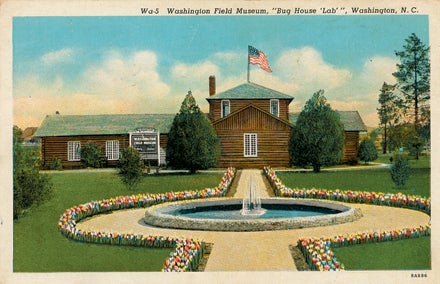Foundation beautifies, commemorates Bug House site
Published 8:22 pm Thursday, August 18, 2016

- JONATHAN ROWE | DAILY NEWS A MOVEMENT: Bug House Laboratory, started by four young boys in Washington, eventually became Washington Field Museum, gaining statewide and national fame, and at one time, was considered the largest amateur museum in the United States. Lantana and knockout roses now grace the site’s grounds.
It stood as a beacon of nature, resulting from the hard work and advocacy of four young boys. It started a local movement and served as a draw to Washington, bringing lovers of nature and wildlife from all over the nation. Now, the Washington Area Historic Foundation is working to beautify and commemorate the landscape, which once housed the Bug House Laboratory, sponsor of the Washington Field Museum.
It’s now known as Bug House Park, a patch of land off of East Third Street that is a mere footprint to the attraction it was in its heyday.
The laboratory was born in 1923 from a love of collecting and studying specimens of insects, reptiles and mammals in the region. The founders began with a tent in one of their backyards and a visit from a girl who claimed the structure was reminiscent of a bughouse gave life to the name. Since the name Bug House was not considered fit for a proper name for a museum, the group decided to use the name Washington Field Museum, to be sponsored by the Bug House Laboratory, according to a book about the museum, written by Elizabeth Yert Sterling.
The building, a log cabin structure, was funded by the sponsorship of community members donating for the purchase of materials, according to Monica Ferrari, a member of the Washington Area Historic Foundation.

WILLIAM PITT
REVIVING A LANDMARK: Members of the Washington Area Historic Foundation came together to beautify an area surrounding a brick monument, commemorating Washington Field Museum, sponsored by Bug House Laboratory, an organization started by four young boys in the 1920s.
The founders and subsequent members were tasked with setting up new exhibits and organizing the museum to attract visitors. Fishponds were built, brick walks were laid in the park, cages for animals were built and filled with various species, and trees were planted. The grounds also included a large, bubbling foundation.
The museum continued to grow, bringing prominent and distinguished and researchers from all over the nation, including universities and national museums, Ferrari said.
The museum held the honor of having, at one time, the largest collection of living reptiles in the state of North Carolina, equaling 412 specimens, according to Sterling’s book. The site was also home to the annual Tulip Festival, and a unique windmill was erected on the rocks in the center of Jack’s Creek, maintaining the Dutch-themed attraction.

WILLIAM PITT
ADVOCATES: Monica Ferrari, Dee Congleton, Jerry Creech and Mary Pat Musselman planted knockout roses and lantana, with plans for more improvements at Bug House Park. Not pictured are Charles Bowen and Donald Stroud.
It grew to statewide and national fame and became a member of the American Association of Museums in 1931. The museum was also considered, at one time, the largest amateur museum in the nation, according to Ferrari.
Eventually, World War II brought an abrupt closure to the museum, according to Sterling’s book. Men of the organization were called to arms, and the museum, depleted of staff, had to close its doors. The city later took the building and opened it as a recreational center, and the entire contents of the museum were removed and stored in the hope the museum would one day reopen.
After the war, due to lives lost and a scattered membership, the Bug House opted not to reopen its doors and donated all the specimens and research to the city, which made no use of the material and eventually disposed of it, according to Ferrari. Later, the structures standing on the site were bulldozed, leaving nothing more than landscape.

DEE CONGLETON
FOOTPRINT: A postcard from 1939 illustrates the beauty and pristine grounds of the Washington Field Museum, supported by the Bug House Laboratory. Tulips surrounded a large, bubbling fountain, and the site and museum grew to attract visitors from all over the nation, including distinguished and prominent scientists from national institutions of education, as well as museums.
Ferrari said the Washington Rotary plans to make improvements to the park in the future, but in the meantime, WAHF asked permission of the city to plant flowers at the site and beautify its grounds
“We are not just advocates for the preservation of buildings, but also for landscapes,” said Donald Stroud, president of WAHF. “We are not above getting our hands dirty in our efforts to restore and clean up areas. Look at Harding Square; how beautiful it is for all seasons.”
Ferrari said the foundation’s improvements are a memorial to not only the museum itself, but also the men involved in the museum who lost their lives during the war. All that is left at the park is a plaque, marking the existence of the museum and laboratory, as well as flora newly planted by WAHF, which includes knockout roses and lantana. In the future, WAHF members plan to plant Liriope and bushes and perhaps install benches and sculptures resembling bugs, according to Congleton.
“We had a very successful Spring Homes Tour and working on Bug House Park is a way to give back to the community,” Congleton said. “It was a wonderful place for all the people of the area, and I think it’s time for that park to be restored. The foundation wants to be an advocate for historical landmarks and for preservation and protection of Washington’s history.”
“I would say, personally, it should live in the memory of those whose lives were touched by it,” Ferrari said. “The memories are an enduring memorial to the boys who didn’t come back from the war; the boys who put so much work into that and never came back from war. (Their work) put Washington on the map. Even though I don’t have personal memories of the park, just reading about it touches me, and what this community did with this park. I’d like to see it come back in some way to commemorate what this park once was.”





